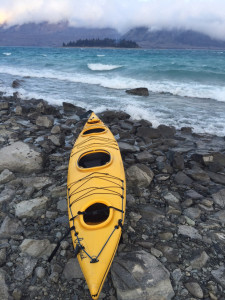The temperature of the water upon which Scouts conduct boating or rafting activities is a major risk factor, the potential effect of which may be ignored more often than not. However, no aquatic activity should be planned and carried out without due consideration given to the water temperature. The effect of cold water on participants in an aquatic activity can, at a minimum, be serious, if not potentially tragic. Remember, we are dealing with youth here! And, adults are not immune . . .
 The BSA Aquatics Supervision manual (Chapter 14) states that at water temperatures below 60 F, boaters should wear insulating clothing such as a wet or dry suit. At water temperatures below 50 F, “cold water shock” is said to set in fairly quickly, which the manual warns “causes an involuntary gasp for air, sudden increases in heart rate and blood pressure, and disorientation”.
The BSA Aquatics Supervision manual (Chapter 14) states that at water temperatures below 60 F, boaters should wear insulating clothing such as a wet or dry suit. At water temperatures below 50 F, “cold water shock” is said to set in fairly quickly, which the manual warns “causes an involuntary gasp for air, sudden increases in heart rate and blood pressure, and disorientation”.
Under such conditions, physical incapacitation can occur in less than 30 minutes. There have been a number of reported Scouting boating incidents where the effect of cold water appears to have been a contributing factor to the outcome.
This means that, early in the boating season, such as at Northern Tier, the water temperature may be a significant risk factor. Which means groups should have an understanding of what the temperature of the water actually is in the event that it might be a significant risk factor (based on locale, time of year, body of water, etc.). Bring a thermometer!
Ocean or open water boating can be particularly hazardous due to the water temperature as confirmed by this ocean kayak story, and by this Clilean kayak tragedy involving the founder of North Face. See, also, this story about a tragic ending to a Maine open water kayaking activity. And, this tragic Scouting story involving canoeing (and capsizing) on a cold, wilderness lake in Canada, and this tragic story involving capsizing in the cold waters of Yellowstone lake.

In other words, it is imperative that participants dress for the water temperature. See Chapter 14 of BSA’s Aquatics Supervision manual (2013 edition) for a discussion of cold water safety. Unprotected immersion in cold water can be life threatening, irrespective of the air temperature.
Attention is directed to the informational websites National Center for Cold Weather Safety, and Coming Back Alive, which include a number of tragic cold water boating stories. See, also, this commentary about the dangers of boating on cold water, with the possibility of long-term immersion.
And, there is this story about a potential tragedy involving swimming in the cold waters of Yellowstone National Park.
Christopher Cunningham, in his book Sea Kayaker’s More Deep Trouble (2014), makes clear the hazards of cold water boating, stating, “It’s better to not think of hypothermia in terms of how long you can survive [in cold water]. The real question is how long you have before you make your first bad decision and how long you have before you’re unable to help yourself [or others].”
For further information on the adverse effect of cold water on unprotected boaters, attention is directed to the American Canoe Association movie “Cold, Wet, and Alive” which may be viewed at this link on YouTube.
Finally, here is a comment received by the author from a scout leader concerning canoeing on cold lakes and rivers in early summer in Maine:
“My troop recently conducted a canoe tour on the Allagash Wilderness Waterway in Maine. Your webpage has a very useful article on the cold-water hazards. It guided me to research the risks we faced in paddling the lakes and river with water temperatures ranging from 55 to 65 degrees. The reference to the BSA Aquatics Supervision Manual carried the day for us, showing the need to use thermal protective gear. Fortunately, we did not have any accidental immersions in the colder lake waters. While on whitewater, we had several overturned canoes in the river in 64 degree water. The use of wetsuits was much more appreciated by those ending up in the water. Thanks for your effort to create and maintain your website. I look forward to learning more from your book.”
